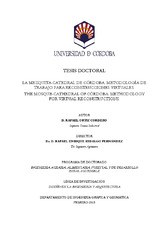La Mezquita-Catedral de Córdoba. Metodología de trabajo para reconstrucciones virtuales
The Mosque-Cathedral of Cordoba. Methodology for virtual reconstructions
Autor
Ortiz Cordero, Rafael
Director/es
Hidalgo Fernández, Rafael EnriqueEditor
Universidad de Córdoba, UCOPressFecha
2018Materia
Reconstrucciones virtuales3D
Estratigrafía 3D
Edificios históricos
Monumentos
Mezquita-Catedral (Córdoba, España)
Patrimonio cultural
Patrimonio de la Humanidad
METS:
Mostrar el registro METSPREMIS:
Mostrar el registro PREMISMetadatos
Mostrar el registro completo del ítemResumen
La presente tesis pretende ser la guía mediante la cual se puedan llevar a cabo
reconstrucciones virtuales correctamente documentadas. Dejando a un lado las
recreaciones virtuales hiperrealistas para el sector turístico y la difusión, en este caso se
plantean reconstrucciones con rigor científico. Sirviendo de esta forma las
reconstrucciones, a los distintos profesionales, como pueden ser arqueólogos, arquitectos,
historiadores, historiadores del arte, ingenieros y todos aquellos que desarrollan su vida
profesional en el campo del patrimonio y la arquitectura.
Haciendo uso de estadística, geometría, levantamientos tridimensionales CAD, estudios de
fluidos e incluso programación y lecturas estratigráficas tridimensionales, se pretende
realizar una metodología de trabajo que incorpore, mejore y añada nuevas técnicas
necesarias para llevar a cabo una reconstrucción virtual científica de cualquier
emplazamiento, tanto arqueológico como arquitectónico. Los ejemplos necesarios para
verificar la metodología fueron llevados a cabo en la Mezquita-Catedral de Córdoba.
La rápida utilización de las reconstrucciones virtuales que se está realizando en el ámbito
patrimonial demuestra la utilidad, e importancia, de estas reconstrucciones. Permitiendo
mejorar el conocimiento y la difusión de nuestra historia. No obstante, estas herramientas
también precisan del establecimiento de unas pautas, de forma que todos los trabajos
realizados tengan una sólida base científica y muestren claramente el conocimiento que se
tiene del bien patrimonial intervenido.
La realización de la tesis ha llevado a diversos resultados y conclusiones. Entre ellos la
mejora de la escala de certidumbre para las reconstrucciones virtuales, el análisis de las
columnas del sector de ‘Abd al-Rahman I de la Mezquita-Catedral de Córdoba, obteniendo
conjuntos de columnas provenientes de un mismo edificio y su esquema de colocación.
Además, se ha hallado el tiempo de llenado y la capacidad de agua del aljibe de Almanzor
entre otros.
Todos estos resultados han generado no solo una metodología de trabajo para realizar
reconstrucciones virtuales, sino que también han generado una serie de futuras líneas de
investigación que se seguirán estudiando. This thesis aims to be the guide through which properly documented virtual reconstructions
can be carried out. Reconstructions with scientific rigor are proposed, leaving aside virtual
recreations for the tourism sector and diffusion. These reconstructions are useful to
different professionals, such as archaeologists, architects, historians, art historians,
engineers and all those who develop their professional careers in cultural heritage and
architecture.
We carry out a methodological work that incorporates, improves and adds new techniques
necessary to make a scientific virtual reconstruction of any location, both archaeological
and architectural. For this purpose, we make use of statistics, geometry, three-dimensional
CAD surveys, fluid studies and even programming and three-dimensional stratigraphic
studies. The necessary examples to verify this methodology were carried out in the Mosque-
Cathedral of Córdoba.
The rapid use of virtual reconstructions that are being carried out in cultural heritage
demonstrates the usefulness and importance of these reconstructions. These
reconstructions enable professionals of the fields mentioned above to improve the
knowledge and dissemination of our history. However, these tools also require the
establishment of some guidelines, so that all the works conducted have a solid scientific
basis and clearly show the knowledge we have of the cultural heritage.
The realization of this thesis has led to various results and conclusions. Among them the
improvement of the scale of certainty for virtual reconstructions, the analysis of the
columns of the sector of 'Abd al-Rahman I of the Mosque-Cathedral of Córdoba, obtaining
groups of columns from the same building and its scheme of placement. In addition, the
filling time and the water capacity of the Almanzor’s cistern among others have been found.
All these results have generated not only a work methodology to perform virtual
reconstructions, but they have also have generated a series of future lines of research that
will continue to be studied.

